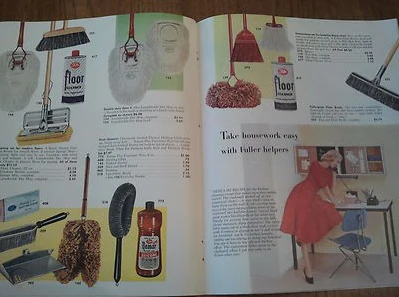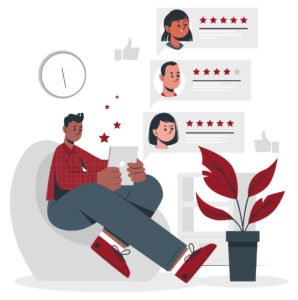Your cart is currently empty!

Mastering the Art of Non-Icky Marketing Funnels: Lessons from the Fuller Brush Man
Reading Time: 15 minutesAuthor:
In a world where consumers are bombarded with countless marketing messages, cutting through the noise has become the ultimate challenge for businesses.
How much noise is there?
The average person encounters between 6,000 to 10,000 marketing messages every single day.
With so much clutter, how can your marketing stand out without resorting to pushy tactics?
The answer might surprise you: by taking a page from the playbook of a door-to-door salesman.
Enter the Fuller Brush Man—a quintessential figure from a bygone era who mastered the art of non-icky marketing. By understanding and applying the principles used by these iconic salesmen, you can revolutionize your approach to creating powerful and, dare I say, ethical digital marketing funnels.
In this comprehensive guide, we’ll explore:
- How to build a marketing funnel that breaks through the noise
- Strategies businesses can use to create meaningful connections with their audience
- Practical tips for optimizing each stage of your marketing funnel
- Real-world examples of successful, non-icky marketing funnels
- Methods to measure and improve your funnel’s performance
Whether you’re struggling to make your voice heard in the crowded B2B landscape, looking to boost e-commerce conversions without resorting to pushy tactics, or simply trying to understand how to create marketing funnels that doesn’t get lost in the shuffle, this article will provide you with actionable insights to elevate your approach.
Are you ready to learn how to craft a non-icky marketing funnel that breaks through the noise and connects authentically with your audience?
Let’s dive into the timeless wisdom of the Fuller Brush man and discover how it applies to today’s marketing challenges.

Marketing Funnel Stages: From Doorstep to Sale
In today’s noisy marketing landscape, understanding and optimizing each stage of your funnel is crucial. Let’s look at the stages through the lens of the Fuller Brush man’s approach, adapting his time-tested techniques for the digital age.
Top of the Funnel – Opening Doors in a World of Closed Tabs

Just as the Fuller Brush man carefully selected his neighborhoods, your digital marketing efforts must start with precision targeting. To break through, your top-of-funnel marketing needs to be relevant to your ideal customer and as attention-grabbing as a knock on the door.
Middle of the Funnel: Keeping the Conversation Going

Once you’ve grabbed their attention, the challenge is maintaining interest in a world of short attention spans. This is where the Fuller Brush man’s demonstration techniques come into play in your digital strategy.
- Show, Don’t Just Tell: Use video content, interactive demos, and engaging infographics to showcase your product’s benefits, much like a live product demonstration.
- Social Proof in the Digital Age: Leverage customer reviews, testimonials, and case studies – the modern equivalent of neighborhood word-of-mouth.
- Active Listening, Digital Style: Use analytics and user behavior data to understand customer needs and tailor your content accordingly.
Bottom of the Funnel: Closing the Sale Without the Hard Sell

At this stage, your goal is to convert interest into action while maintaining the non-icky approach that sets you apart in your prospect’s mind.
- Focus on Problem-Solving: Frame your call-to-action around how your product or service solves specific customer pain points.
- Simplify the Purchase Process: Streamline your checkout or sign-up process, removing any friction that might cause hesitation.
- Add Value at the Point of Decision: Offer incentives or bonuses for immediate action, similar to the Fuller Brush man’s special offers.
Post-Purchase – Nurturing Relationships in the Digital Era

The sale isn’t the end—it’s the beginning of a potentially long-lasting relationship. In the digital world, this stage is more important than ever.
- Personalized Follow-ups: Use email marketing and retargeting to stay connected, much like the Fuller Brush man’s repeat visits.
- Continuous Value Delivery: Provide helpful content, exclusive offers, and stellar customer service to keep customers engaged and loyal.
- Turn Customers into Advocates: Encourage and incentivize referrals and reviews, creating a digital version of neighborhood recommendations.
By applying these timeless principles to each stage of your digital marketing funnel, you can create a strategy that not only cuts through the noise but also builds lasting, valuable relationships with your customers.
There’s one other thing I’d like to make clear, a marketing funnel and a sales funnel are not the same. The marketing funnel is the process or steps you use to attract and convert a prospect. A sales funnel is what you do after the initial purchase to increase the average order size. For more on sales funnels, read our post, What is a Sales Funnel?
In our next section, we’ll dive deeper into how to optimize each of these stages for maximum impact.
Top of the Funnel
Opening Doors When Everyone’s Wearing Noise-Canceling Headphones
It’s no secret that we’re all drowning in a sea of marketing messages. From the moment we wake up to check our phones to the ads that follow us across the web, it’s like everyone’s shouting for our attention.
Sound familiar?
Let’s face it: getting noticed in this chaos is about as easy as selling ice to an Eskimo.
But what if we could learn a thing or two from a guy who sold brushes door-to-door?
Finding Your People in a World of Scroll-By Zombies
The Fuller Brush man didn’t just knock on any old door. He knew his crowd. In the digital world, you need to do the same thing. It’s about finding your tribe amidst the chaos. Said another way, it’s about marketing that aligns with your customer’s needs so it’s seen by them.
- Digital Detective Work: Dig into where your ideal customers hang out online. Are they Instagram addicts or LinkedIn lurkers?
- Be the Square Peg in the Round Hole: Place your message where it stands out, not where it blends in. Think of it as wearing a tuxedo to a pajama party – you’ll get noticed but in a good way.
- Solve their Problems: Align your content with what keeps your audience up at night. Be the aspirin to their headache.
Your Elevator Pitch on Steroids
I’m sure you’d agree that in a world of TikTok attention spans, you’ve got to hook ’em fast. The Fuller Brush man had a similar challenge. He only had a few seconds at the door; you’ve got even less.
- Headlines That Slap: Craft titles that make scrolling thumbs screech to a halt. Think less “10 Tips for Success” and more “Why Your To-Do List is Making You Miserable.”
- Show, Don’t Tell: Use visuals that tell a story faster than words. A picture is worth a thousand words, but a great GIF might be worth a million clicks.
- Value Bomb Drop: Quickly hit them with why they should care. What’s in it for them? Make it crystal clear, fast.
When introducing myself at a networking event, I use the following: “You know how important digital marketing is, but it’s all so confusing and overwhelming? I’m James, and I’m on a mission to demystify digital marketing for six-figure business owners who are investing in marketing to drive growth.” In two sentences, I’ve poked their pain, provided a solution, identified who my audience is and who it isn’t, and highlighted the benefit of working with me.
Effective marketing is outside-in marketing. Don’t shout at customers from the top of your building; get down on the street and walk with them.
Tailor Your Pitch Like You Know Them
The Fuller Brush man didn’t use the same spiel on everyone. A one-size-fits-all pitch isn’t the answer to breaking through the noise.
- Content Chameleon: Use AI tools to shape-shift your content based on who’s looking. Customer avatars help with this. It’s like having a thousand different sales pitches ready to go.
- Digital Déjà Vu: Change up your approach for folks who’ve window-shopped with you before. “Hey, welcome back!” beats “Nice to meet you” any day.
- Split Test Like Your Paycheck Depends on It: Because, let’s face it, it probably does. Keep testing until you find what makes your audience tick.
Keeping That Digital Door From Slamming Shut
In a world where closing a browser tab is easier than blinking, your job is to make them want to stick around.
- Crystal Clear Next Steps: Make your CTA so obvious that even your grandma could figure it out. “Click here to change your life” beats “Submit” or “Learn More” any day of the week.
- Speed is King: If your page loads slower than a snail on tranquilizers, you’re dead in the water. Make it snappy! And did you know that page load speed is a trust event?
- Freebie Frenzy: Offer something valuable upfront. It’s like leaving a trail of digital breadcrumbs they can’t resist following.
By nailing these points, you’re not just another face in the crowd – you’re the dude people actually want to talk to at the party.
Stick around because next, we’re going to discuss how to keep the conversation going once you’ve got their attention.
Trust me, it’s trickier than keeping a toddler entertained, but stick with me here; I’ve got some ideas that might blow your mind.
Middle of the Funnel
Maintaining Engagement in a Distracted World
Congratulations on capturing initial attention. They’re looking at you. Do you have a mid-funnel marketing plan?
Let’s look at how the Fuller Brush Man does it and explore their techniques for keeping their audience engaged.
Elevating the Demonstration
The Fuller Brush man excelled at product demonstrations. In our digital landscape, we need to create equally compelling experiences.
- Video Content: Develop concise, engaging video content that communicates your value proposition quickly. Aim for content that’s so captivating it momentarily distracts from other digital diversions.
- Interactive Demonstrations: Create interactive demos that allow potential customers to experience your product or service firsthand. The goal is to make learning about your offering both informative and enjoyable.
- Visual Information: Design infographics that distill complex information into easily digestible visuals. Strive for clarity and aesthetic appeal to enhance understanding and retention.
Leveraging Social Proof in the Digital Age
The Fuller Brush man understood the power of neighborhood recommendations. In our interconnected world, we can amplify this concept exponentially.
- Strategic Review Placement: Prominently showcase positive reviews across your digital platforms. Ensure that potential customers can easily find and relate to these testimonials.
- Video Testimonials: Incorporate video testimonials for a more personal touch. Authentic stories from satisfied customers will significantly influence decision-making.
- Comprehensive Case Studies: Develop detailed case studies that illustrate real-world applications and benefits of your product or service. Make these narratives engaging and results-focused.
Data-Driven Engagement
While the Fuller Brush man relied on instinct based on keen observation, we have the advantage of sophisticated analytics tools. Let’s use them wisely.
- Analytics Insights: Dive deep into your analytics data to understand user behavior. Use UTM tracking to follow audience interactions.
- Behavior Analysis: Pay close attention to metrics like time on page and bounce rates. These indicators can reveal which content resonates most with your audience.
- Adaptive Content Strategy: Use these insights to refine your content strategy continuously. Be prepared to pivot quickly based on performance data.
The Art of Valuable Persistence
The key is to remain present in your audience’s mind without becoming an unwelcome intrusion. This requires a delicate balance of timing and value delivery.
- Consistent Value Delivery: Regularly provide high-quality, relevant content that addresses your audience’s needs and interests. It’s not about you, it’s about them.
- Strategic Timing: Perfect the art of reaching out at opportune moments. Map your buyer’s journey.
- Personalized Communication: Tailor your outreach based on individual user data and behavior. The more relevant your communication, the more likely it is to be well-received.
Mid-funnel marketing is your opportunity to build relationships and trust with prospects. Don’t squander it. Don’t be a fleeting presence in their digital day; become a valuable resource they actively seek out.
Our next section will explore the critical bottom-of-the-funnel stage, where we convert this cultivated interest into concrete action. We’ll discuss how to close the deal effectively while maintaining the trust and goodwill you’ve worked so hard to build.
Bottom of the Funnel
Convert Interest Into Action
You’ve successfully guided your audience through the awareness and consideration stages. Now comes the crucial moment: turning that cultivated interest into tangible action. This is where the Fuller Brush man’s closing techniques can offer valuable insights for our digital age.
Focus on Problem-Solving
The Fuller Brush man didn’t just sell brushes; he sold solutions to everyday problems. We need to adopt a similar approach.
- Pain Point Precision: Frame your call-to-action around specific customer pain points. Make it clear how your product or service provides a unique solution.
- Benefit-Driven Language: Instead of listing features, emphasize the tangible benefits and outcomes customers will experience.
- Contextual Relevance: Tailor your messaging to recognize where the customer is in their journey. Don’t tell them what they already know. Craft your pitch to draw them along.
Streamline the Purchase Process
Any friction in the buying process can lead to abandoned carts and lost opportunities. The statistics are sobering:
- According to a study by the Baymard Institute, the average online shopping cart abandonment rate in 2024 is 70.19%.
- The same study found that 22% of U.S. online shoppers have abandoned an order in the past quarter solely due to a “too long/complicated checkout process.”
- In the past, I’ve analyzed traffic degradation at each click in the pathway. As much as 60% of traffic is lost at each click. This is why the hamburger menu, which was a trend in website design, is no longer common. Look at Google Analytics, and you will see similar patterns.
Source: Baymard Institute, “41 Cart Abandonment Rate Statistics” (2024)
To combat these issues:
- Clear Next Steps: Make it easy for users to know what to do
- Intuitive User Flow: Design your checkout or sign-up process to be as straightforward and user-friendly as possible. Every click is a potential exit point.
- Mobile Optimization: Ensure your conversion process works seamlessly on mobile devices. A significant portion of your audience will be making decisions on-the-go.
At every stage, clearly communicate the action you want the user to take next. Eliminate any confusion that might lead to hesitation. Questions are traffic killers.
The lower funnel is the vital transition point where prospects become customers. Have a plan.
For more on this topic, read Lower Funnel Marketing Demystified.
Add Value at the Point of Decision
The Fuller Brush man often sealed the deal with a special offer or bonus. We can apply this concept to create a compelling final push.
- Limited-Time Offers: Time-sensitive deals or bonuses create a sense of urgency. However, this tactic can diminish trust if employed too frequently.
- Bundle Value: Offer complementary products or services that enhance the overall value of the purchase. This can increase both the perceived value and the average order value.
- Risk Reversal: Address potential hesitations head-on by offering guarantees, free trials, or easy return policies. Minimize the perceived risk of making a decision.
Maintain Trust Through Transparency

In an era of heightened skepticism towards marketing, maintaining transparency is crucial for closing the deal ethically.
- Clear Communication: Be upfront about pricing, terms, and what customers can expect post-purchase. Avoid hidden fees or complicated conditions that might erode trust.
- Authentic Testimonials: Showcase real customer experiences that relate specifically to the decision-making process. Let potential customers see themselves in these stories.
- Address Objections Proactively: Anticipate common concerns and address them before they become roadblocks. This demonstrates confidence in your offering and respect for the customer’s decision-making process.
By implementing these strategies, you’re not just pushing for a sale; you’re guiding the customer to a decision that genuinely benefits them. The goal is to make the purchase feel like the next logical step in the customer’s journey, not a high-pressure decision point. This approach not only increases your conversion rates but also sets the stage for long-term customer relationships and brand advocacy.
In our final section, we’ll explore how to nurture these relationships post-purchase, turning one-time buyers into loyal brand ambassadors. Just as the Fuller Brush man knew the value of repeat visits, we’ll discuss how to keep the conversation going in the digital age, ensuring that your funnel doesn’t end at the point of sale but continues to build lasting customer relationships.
Beyond the Sale
Nurturing Relationships in the Digital Era
The Fuller Brush man understood that the sale wasn’t the end—it was the beginning of a potentially long-lasting relationship. In our digital landscape, this principle is more crucial than ever. Let’s explore how to transform one-time buyers into loyal brand advocates.
The Power of Post-Purchase Engagement
In the digital world, the moments immediately following a purchase are golden opportunities for deepening customer relationships. Customers are highly interested in you and your offer. They are looking for signs that they have made a good decision and that you value the relationship. Don’t be a product with a name. Build relationship equity that serves as competitive insulation.
- Immediate Confirmation: Send a personalized thank-you message immediately after purchase. This isn’t just transactional—it’s the digital equivalent of a warm handshake.
- Onboarding Sequence: Develop a series of welcome emails or in-app messages that effectively guide new customers through using your product or service. Add value that goes beyond transactional benefits.
- Anticipate and Address Concerns: Proactively reach out with information that addresses new customers’ common questions or concerns, heading off potential issues before they arise.
Personalized Follow-ups – The Digital House Call
Just as the Fuller Brush man would make repeat visits, you need to use email marketing to maintain consistent, valuable connections with your customers.
- Segmented Email Campaigns: Use purchase history and behavior data to create highly targeted follow-up campaigns. The more relevant your communication, the more likely it is to be well-received.
- Personalized Product Recommendations: Leverage AI and machine learning to suggest products or services that complement their previous purchases.
- Milestone Celebrations: Acknowledge customer anniversaries or usage milestones. This shows that you value their ongoing relationship with your brand.
Continuous Value Delivery
To keep customers engaged over time, you must consistently provide value beyond transactional benefits.
- Educational Content: Develop a content strategy that helps customers get the most out of their purchases. This could include how-to guides, webinars, access, or exclusive tips for product use.
- Community Building: Create spaces (like forums or social media groups) where customers can connect, share experiences, and learn from each other.
- Loyalty Programs: Implement a rewards system that incentivizes repeat purchases and engagement with your brand.
Turning Customers into Advocates
Word-of-mouth was crucial for the Fuller Brush man, and it’s equally important in our digital age. Advocacy is one of the five ways loyal customers deliver value to your business.
- Referral Programs: Develop a structured referral program that rewards customers for bringing new business your way.
- User-Generated Content: Encourage customers to share their experiences with your product on social media. Consider running contests or featuring customer stories in your marketing materials.
- Feedback Loops: Regularly solicit and act on customer feedback. This improves your product and makes customers feel valued and heard.
Measuring Long-Term Success
To ensure your post-purchase strategies are effective, it’s crucial to track the right metrics:
- Customer Lifetime Value (CLV): Monitor how much a customer spends with you over time, not just in a single transaction.
- Net Promoter Score (NPS): Regularly assess how likely your customers are to recommend your brand to others.
- Repeat Purchase Rate: Track the percentage of customers who make additional purchases over time.
By focusing on these post-purchase activities, you’re not just closing a sale—you’re opening a relationship. You’re creating a cycle of value that keeps customers coming back, much like how the Fuller Brush man became a welcome and expected visitor in many homes.
This long-term relationship-building sets successful brands apart. This is especially important when competitors are just a click away. It transforms your marketing funnel from a linear path to a circular journey, where satisfied customers become a valuable business asset.
As we conclude, remember that in both the Fuller Brush man’s era and today’s digital age, the fundamental principle remains the same: focus on solving problems, delivering value, and building relationships. By doing so, you’ll not only break through the noise but create a loyal community around your brand.

The Non-Icky Marketing Funnel – Conclusion
As we’ve explored the non-icky marketing funnel, we’ve seen how the timeless wisdom of the Fuller Brush man is still relevant today. Let’s recap the key takeaways.
Crafting a Customer-Centric Journey
- Break Through the Noise: In a world saturated with marketing messages, focus on being relevant, timely, and valuable to your audience.
- Support the Customer’s Journey: Each touchpoint in your marketing funnel should efficiently and effectively guide the customer toward a solution to their problem.
Optimizing Each Funnel Stage
- Top of the Funnel: Use targeted advertising to attract the right prospects and quickly communicate your unique value proposition.
- Middle of the Funnel: Engage interest through demonstrations, social proof, and personalized content that addresses customer questions, obstacles, and needs.
- Bottom of the Funnel: Focus on problem-solving, streamline the purchase process, and add value at the decision point to convert interest into action.
Leveraging Digital Tools Effectively
- Personalization: Use data, analytics, and email marketing to tailor your approach to individual customer preferences and behaviors.
- Content Strategy: Develop a mix of content types (video, interactive demos, infographics, and more) to keep your audience engaged throughout the funnel.
- Continuous Optimization: Regularly analyze your funnel’s performance and be prepared to adjust your strategy based on data insights.
Building Long-Term Relationships
- Post-Purchase Engagement: View the sale not as the end goal but as the beginning of a lasting customer relationship.
- Deliver Ongoing Value: Continue to provide value through educational content, community building, and personalized recommendations.
- Turn Customers into Advocates: Implement referral programs and encourage user-generated content to amplify word-of-mouth marketing.
Remember, the most important sale is not the first sale; it’s the second sale. By focusing on solving problems, delivering consistent value, and building genuine relationships, you create a marketing funnel that converts efficiently and fosters loyalty and advocacy.
Your competitors are just a click away. This approach will set you apart. It transforms your marketing funnel from a simple conversion tool into a powerful engine for sustainable growth. By applying these principles, you’re not just breaking through the noise—you’re creating meaningful connections that resonate in the short term and over time.
As you implement these strategies, keep the spirit of the Fuller Brush man in mind:
- be helpful,
- be genuine, and
- always prioritize the customer’s needs.
Doing so will create a customer-centric marketing funnel that’s not just effective but also ethical—a big win in digital marketing.
Marketing Funnel FAQs
The stages of a marketing funnel are typically awareness (top of the funnel), consideration (the mid-funnel), and action (bottom of the funnel).
The most important sale is the second sale. Make sure that your marketing funnel works toward this goal. The second sale demonstrates customer satisfaction, and having happy existing customers greatly increases the chances of a third sale.
Microtransactions build trust with your customers by providing them with interactions of increasing value. This builds a positive reputation, further strengthening customer loyalty and enhancing prospective customers’ chances of responding to remarketing.
Related Posts
A Guide for Online Course Creators
Create and sell online courses. Learn how to use your knowledge to transform lives and earn income.
Mastering Mid-Funnel Marketing
Learn how mid-funnel marketing supports the buyer’s journey to conversation and improves customer lifetime value.
Craft a USP for Your Business
Learn how a USP that’s unique, clear and compelling breaks through the noise.
Author: James Hipkin
Since 2010, James Hipkin has built his clients’ businesses with digital marketing. Today, James is passionate about websites and helping the rest of us understand online marketing. His customers value his jargon-free, common-sense approach. “James explains the ins and outs of digital marketing in ways that make sense.”
Use this link to book a meeting time with James.

